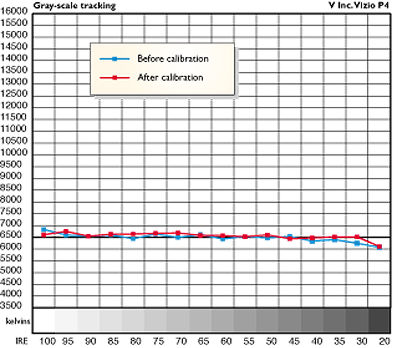V Inc. Vizio P4 46-inch plasma TV Calibration

The Vizio P4's onscreen menus were a little more difficult to use than some I have encountered—the rather large menu box fills almost half the screen, and it doesn't fall away when a video parameter is selected for adjustment. To mitigate that, the P4 lets you move the box around to different areas of the screen so as not to cover a test pattern you're trying to view. To me, this is a rather jury-rigged arrangement. It would have been better to design an onscreen menu system that was not obtrusive so there would be no need to move it around in the first place.—JB
The Warm setting of the Vizio P4's color-temperature control was respectable (see accompanying chart), though it measured a bit lacking in green, and flesh tones looked a bit too red. The Standard setting measured 9000–10,000 kelvins, and the Cool setting went from just under 12,000K to over 13,000K. The red color point was very accurate, but the green was shifted deeper into green than the standard, and the blue was shifted slightly toward greenish-blue.
After calibration, the kelvin readings were similar to those of the Warm preset, but the actual color points were closer to the desired D6500. These measurements were made at a contrast setting (Contrast = 30) that resulted in a peak white of 30 footlamberts. At this setting, however, the darkest grays (well under 20fL) looked clearly reddish. Dropping the Contrast setting much lower than 30 actually raised the black level (brightness) significantly, washing out the picture. I obtained the best overall picture with Contrast set at about 40, which produced a peak white level of about 46fL in a 100 IRE white window (Video Essentials, chapter 17-10) and 13.6fL with a full 100 IRE white field (VE, 18-14). This dropoff in peak white as the bright area of the picture increases in size is characteristic of plasma displays, but in my experience, it's not visible to the eye on normal program material.
I measured a peak (on/off) contrast of 92, and a 16-square checkerboard contrast (ANSI) of 103. The subjective contrast was better than the measurements, though the blacks were a little crushed and not as deep and detailed as in the best plasmas we've seen (such as far more expensive designs from Panasonic and Fujitsu). Some false contouring was visible in dark shadowed areas.
Overscan measured 4% top, 2% bottom, and 2.5% left and right. The DVD resolution measured about 480 lines per picture height. The image was very crisp; while pixels were visible from close up, they were not an issue from distances beyond about 9 feet.—Thomas J. Norton
- Log in or register to post comments














































